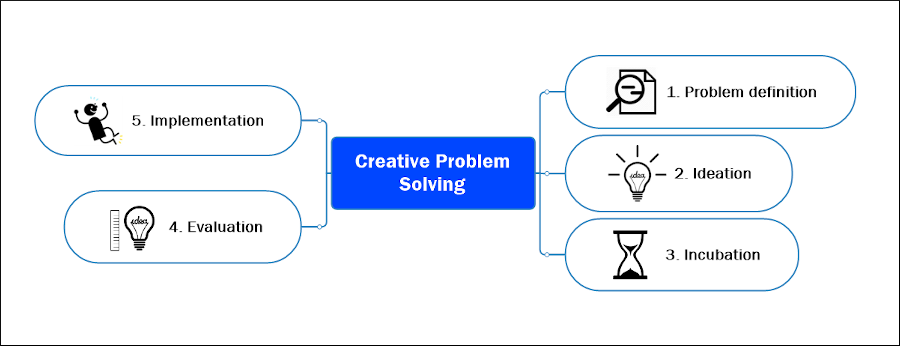
A popular perception about creativity is that it’s random and uncontrollable. Terms like “a flash of insight,” “a bolt from the blue” and the iconic “A-ha!” support this notion. Writers and artists speak of a fickle creative “muse” that ebbs and flows unpredictably.
There’s only one problem with this traditional approach to creativity: It’s not sustainable or scalable.
A more reliable way to be consistently creative is to adopt a proven process for ideation and creative problem-solving, like this proven 5-step process:
- Investigation
- Ideation
- Incubation
- Evaluation
- Implementation

Here is a brief explanation of what happens at each step – and how mind mapping software can help.
Step 1: Problem definition
Albert Einstein was once asked, “If you knew the world was going to end in one hour, how would you use that time to solve that problem?” He answered that he would spend 55 minutes thoroughly exploring, researching and defining the problem and only 5 minutes brainstorming solutions. He realized that it was essential to accurately define the problem to be solved. All of the exotic thought experiments in the world wouldn’t make any difference if it turned out he was addressing the wrong problem.
The first step of the creative process is investigation – doing a deep dive into the nature of the problem:
- Gather all of the information you can find on the subject. Immerse yourself in it. Do Google searches. Talk to subject matter experts.
- Investigate if any other industries or professions have solved similar problems. If so, how could you adapt them to your needs?
- Break the problem into its component parts using a mind map to see if any of them are solvable.
How mind mapping software can help:
- Use a mind map to capture everything that is known about the problem
- Divide it into its component parts, which enables you to see how they fit together and the patterns between them.
- Identify root causes, instead of getting distracted by symptoms.
- Use a structured set of problem definition questions, such as those contained in the Phoenix Checklist, to accurately define the problem to be solved.
Step 2: Ideation
Now it’s time for the fun part that everyone loves – brainstorming! But it’s more focused now because of the problem definition exercise we did in step one. Keep these brainstorming best practices in mind:
- Your goal is to develop LOTS of divergent ideas. Go for quantity.
- Don’t censor yourself or try to evaluate ideas as you generate them.
- Record every idea, no matter how ridiculous or outlandish. Your craziest ideas may actually be stepping stones to elegant, practical solutions.
- Use prompts, triggers or brainstorming exercises to spur your thinking in fresh directions
- Try to keep going for at least 30 minutes. Remember, you must keep pushing past the easy, top-of-mind, low-value ideas to find the good stuff!
Don’t stop when you generate what looks like the first “right idea.” You know what I’m talking about. The one that makes you exclaim, “Woah! That’s cool!” It’s a common tendency during brainstorming sessions. But it’s a problem: The first ideas you generate will tend to be the lowest value ones. Keep going!
How mind mapping software can help:
- It enables you to capture ideas quickly without worrying about how they’re arranged.
- Some mind mapping programs have a brainstorming mode that enables you to quickly capture ideas fast, using only the keyboard.
- You can use mind map templates for a number of popular brainstorming and creative problem-solving techniques to catalyze your ideation process.
- The infinite canvas of a mind mapping software program means you can explore your ideas in as much depth as you want to.
- Mind mapping software naturally supports ideation, because each topic or node is an opportunity for your brain to generate additional associations and connections.
Step 3: Incubation
After you have brainstormed a wealth of ideas, you shouldn’t jump right into evaluation and implementation. Instead, mentally walk away from them for a few hours or a few days. During this time, even though your conscious mind is occupied with other priorities, your subconscious mind will continue to mull over your creative challenge and your ideas.
That means that your brain is likely to continue to bubble up additional ideas and insights. Make sure you have a way to record them and incorporate them into the list of ideas you’ve already brainstormed.
This is also an opportunity to look for ideas that may be improved or combined. Don’t overlook these opportunities, because you can use them to turn mediocre ideas into really strong ones.
How mind mapping software can help:
- View the ideas you’ve generated as “stepping stones” – what OTHER ideas do they suggest? Capture them in your mind map.
- Are there small ideas that could be combined to make bigger, more valuable ones?
- Now’s the time to experiment with moving around topics and playing “What if?” with your ideas. Remember, every time you move an idea to a new location within your map, you change its context. That, in turn, can spur new ideas, insights and connections.
- Use the SCAMPER technique to improve and expand the ideas you’ve generated. Its name is a mnemonic for Substitute, Combine, Adapt, Modify/Magnify/Minify, Put to other uses, Eliminate and Reverse/Rearrange. It forces you to look at your ideas from seven unique perspectives.
Step 4: Evaluation
Ideas only have value if you implement them. That’s why it’s important to have an organized system for measuring and comparing your ideas. According to creativity experts, there a number of ways to evaluate your ideas. Here are three of the most common:
- Implementation cost
- Ease of implementation
- Resource requirements
I recommend that you select one or two evaluation frameworks. Don’t make this process too complicated. The next step is to create a scale for scoring your ideas. I recommend a scale of 1-5 or 1-10, where higher scoring ideas have greater value. You can also rank ideas using an A/B/C method. It all depends how granular you want to get in your assessments.
Once you have evaluation criteria set up, you can use them to assign values to each of your ideas. If you decide to utilize multiple evaluation criteria, simply add the scores of each individual criterion to arrive at a total score.
How mind mapping software can help:
- Use icons or symbols to rate each idea. You can do this using numerical (1,2,3) or alphabetical (A,B,C) symbols.
- If the mind mapping software you use supports calculation capabilities, you can create multiple subtopics under each idea to score it based on multiple criteria (such as ease of implementation, cost of implementation and resources required). You can then capture the total score in a separate subtopic or even create formulas that enable you to weight each criterion differently.
- The ideas that score the highest are those that are most likely to be doable and which will generate the greatest value if you implement them. You can use your software’s filtering capabilities to display only your top-rated ideas.
Step 5: Implementation
Now that you have identified a handful of ideas that you plan to implement, you need to develop action plans for each of them. Most mind mapping programs enable you to convert any topic into a task, complete with priority level, start and end dates, resources required and more. In short, you can utilize it as a poor man’s project management tool!
How mind mapping software can help:
- Create a separate mind map for each idea. Use it to build out action plans that specify your objectives, information and resources required and other details that describe how you’ll turn your best ideas into reality.
- Use icons and symbols to visually classify the information in your action plan. You can also employ topic shapes and colors to accomplish the same thing.
- Don’t forget that you can use attachments and links to external resources needed to implement your ideas.
- Add task information to your action steps.
Conclusion
As you can see, mind mapping software is a powerful, flexible tool that can help you supercharge the volume and value of your creative output – especially if you adopt a creative problem-solving process like the one I’ve just described.
Happy idea hunting!


Leave a Reply